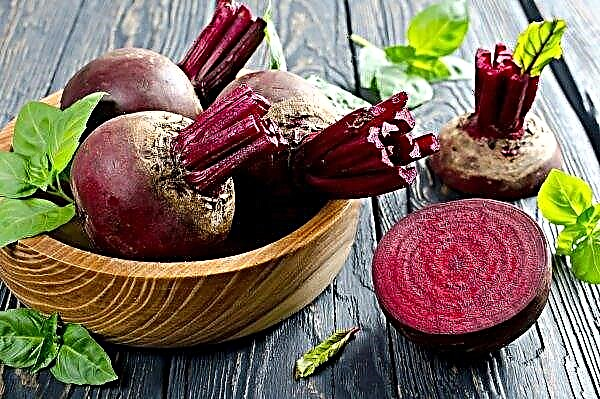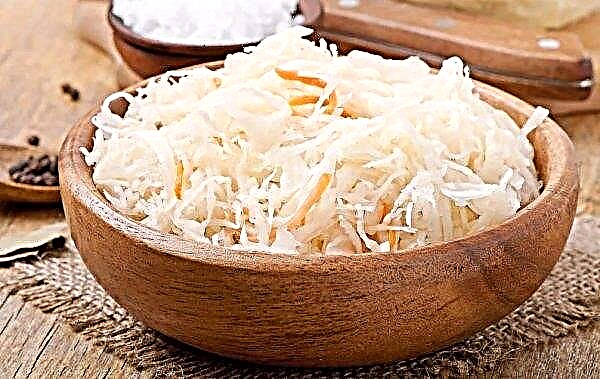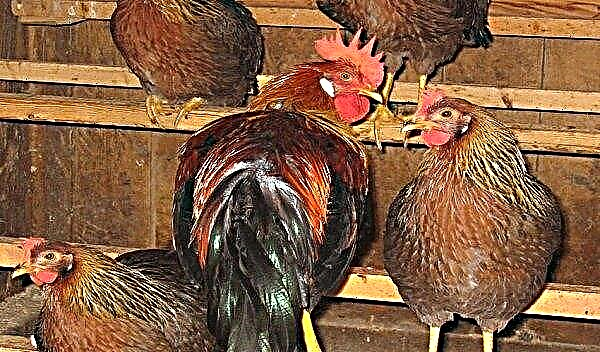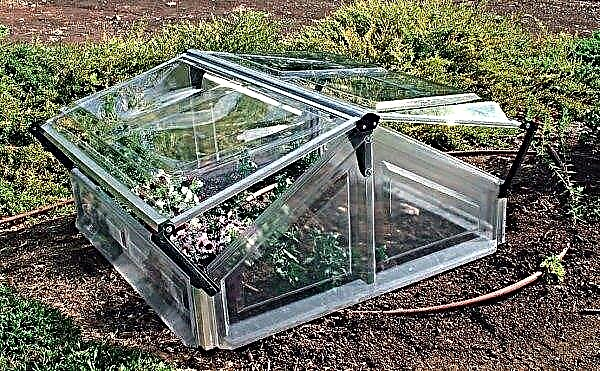Sometimes a forgotten jar of honey remains in the pantry. It can stand there for quite some time, and thrifty consumers do not know how to manage their stocks. This article will introduce you to the changes that occur in the product during storage and how to use old honey.
The chemical composition and calorie content of old honey
The processes of ripening of honey do not stop after pumping, and during storage its chemical composition and properties change. Transformations depend on storage conditions and periods, climatic indicators and room illumination, type of honey, its maturity and pumping time. We will consider the composition of fresh honey and the change in its components during storage.
Calorie content of the product is in the range of 300–330 kcal per 100 g of product, which satisfies the daily requirement of the body by 20–23%.Important! The composition and properties of the bee product vary and depend on the place of collection, weather conditions and plants from which nectar is collected.
Nutrition value (per 100 g):
- proteins - 0.6–1.8 g;
- fats - 0 g;
- carbohydrates - 79–80 g;
- organic acids - 1.2 g;
- water - 17.4 g;
- starch - 5.5 g;
- ash - 0.3 g.
The low water content contributes to the long-term storage of the product under the following conditions: temperature within + 6 ... + 20 ° С and air humidity at the level of 10-60%. If the product was stored under such conditions, then it is quite suitable for use, of course, in the absence of visible signs of spoilage (fermentation, unpleasant odor, bitterness).

The amount of proteins (vegetable and animal proteins) in the composition is small, and there are no fats. Proteins and amino acids (0.1%) are not quantitatively important components and do not increase nutritional value, but provide the honey aroma inherent in the product. During storage, they enter into chemical interaction with other components and sugars, forming melanoidins. The accumulation of these substances causes a darkening and a change in taste and smell. Storage without light at temperatures below + 10 ° C does not change color. Sunlight makes the color of honey less intense.
The aroma of flower nectar under the action of enzymes changes. The longer the shelf life, the fewer the initial flavors that are replaced by derivatives of fermentation.
Carbohydrates (42 species studied) are the main components and are represented by glucose, fructose, sucrose (less than 5%) and other natural sugars and make up 80–90% of all solids.
| Monosaccharides (in%): | Polysaccharides: | Disaccharides: |
|
|
|
The composition of carbohydrates changes over time due to their decomposition under the influence of heat and chemical fermentation. If the product is stored for 2 years at a temperature of + 23 ° C, then the amount of fructose is reduced by 5%, glucose - by 13%. The content of sucrose and maltose increases by 63% and 68%, respectively. The longer the shelf life, the more significant the changes in the composition of carbohydrates, i.e., healthy sugars turn into less useful disaccharides.

With prolonged storage, the product crystallizes, which is associated with the formation of glucose crystals. Such crystals settle to the bottom, and the liquid fraction from fructose rises, which does not crystallize at all. The higher the fructose content, the stronger the product is stratified, which indicates its naturalness. But such a process increases the risk of fermentation and worsens the appearance. Periodic mixing sometimes eliminates this drawback.
Important! State standards give an expiration date to a bee product - 1 year. But this does not mean that after this, honey becomes unsuitable for consumption.
Vitamin components and mineral elements get into the composition with pollen and bee waste products. The content of these elements is small, but the amount of many minerals is almost the same as in human blood.
| Vitamin composition per 100 g of honey: | When stored during the year: |
|
|
Mineral elements enter with nectar and pollen and subsequently change little in quantitative value and are not synthesized.
An important role in the metabolic processes of the human body is played by enzymes (enzymes) of honey, which act on proteins and fats in cells.
The total number of enzymes in the product is 15, of which the most basic:
- diastase (amylase) - contributes to the decomposition of starch and decreases by 2 times within 7 months, and when stored for more than a year (+ 20 ... + 25 ° С) it is completely lost;
- invertase - the secret of the pharyngeal (hypopharyngeal) glands of bees;
- catalase - participates in the formation of gluconic acid.
Video: Honey Properties
During fermentation, the activity of enzymes changes throughout the year. For example, after a year at + 24 ... + 28 ° С, the effectiveness of diastase decreases to 35%. But lowering the storage temperature to + 6 ° C is able to reduce the decrease in the diastatic activity of amylase due to an increase in density and viscosity during the crystallization of honey.
Invertase is destroyed and reduces activity over 9 months by 4 times under the action of direct sunlight and at a temperature of + 27 ° C.
There are many organic acids in the product that are the result of protein synthesis and the basis of amino acids:
- gluconic;
- dairy;
- vinegar;
- apple
- wine;
- maleic;
- formic;
- lemon;
- oil;
- oxal.
Did you know? Millennia later, vessels with honey were found in the Egyptian pyramids and on the bottom of the Mediterranean Sea, which did not lose their qualities and was suitable for food.
Mineral acids are represented by a small amount of phosphoric and hydrochloric. The product has a clearly acidic reaction — its pH is 3.5–4.5. The acids in fresh pumped out honey are the acids of the collected nectar, but in the future organic acids accumulate as a result of enzymatic decomposition of sugars.
The total acidity of honey, which depends on the content of various acids, salts, proteins and carbon dioxide, increases after 2 years of storage (+ 15 ... + 25 ° C) by almost 5 times. It is advisable to eat a product from sunflower with a higher acidity, eat earlier linden or buckwheat.

The content of oxymethylfurfural (OMF), the product of the chemical decomposition of fructose in an acidic environment, when stored for 1–10 years at + 25 ... + 27 ° С depends on the initial number (1–5 mg per 1 kg) and can increase by 200–300 % After pumping, OMF is decomposed by enzymes to a non-toxic state. But with a decrease in enzyme activity, the amount of OMF increases to about 150-200 mg per 1 kg.
Bactericidal activity is due to volatile and essential oils and for 12 months is reduced by 10-16%.
Important! The bactericidal properties of honeydew in hermetically sealed glass jars in a dark place are fully preserved at room temperature for 10 years.
To summarize, we can draw conclusions about changes in the product during storage:
- enzyme activity decreases;
- sugar composition changes;
- oxymethyl furfural accumulates;
- bactericidal activity decreases;
- the amount of vitamins decreases;
- the composition of organic acids and the value of acid activity change;
- a liquid fraction is formed on the surface;
- color changes and darkening occurs.
 The product can be eaten, but most of the medicinal qualities will be lost.
The product can be eaten, but most of the medicinal qualities will be lost.
Useful and harmful properties
- Even old honey is able to have a positive effect, which is manifested in the following properties:
- antimicrobial and antifungal;
- anti-virus and anti-phlogistic;
- nutritious and regenerating;
- painkillers and antiseptic;
- soothing (sedative).
- However, even external use can cause undesirable consequences in the following cases:
- individual intolerance;
- allergy;
- diabetes;
- rosacea.
Caution should be used in pregnancy and lactation and should not be given to children under 2 years of age.
How and where to use old honey
If you are afraid to use old honey in its natural form, then you can find another application for it:
- in beekeeping (leave to feed the bees with a crop failure of nectar);
- in cooking (pastries, confectionery);
- in the industry of beauty and cosmetology (masks, creams, scrubs);
- in alternative medicine (treatment of wounds, burns, skin inflammation).
Even the old product still has a lot of enzymes, amino acids and minerals that can have bactericidal and healing effects.
Did you know? Bees are 60 thousand years older than humans, so honey is considered the oldest natural product.
Anti-dandruff
The antifungal and bactericidal effect of honey can be used in the fight against dandruff and irritation of the scalp. To do this, just add it to shampoo or hair balm. You can directly lubricate the scalp before washing with a slurry of honey and water (or a decoction of medicinal chamomile), leave for 2 hours and then rinse with warm water. The procedure is repeated every 2 days until the problem is resolved.
 If you add onion juice to honey gruel, then you can stop hair loss
If you add onion juice to honey gruel, then you can stop hair loss
To fight a hangover
After a festive feast in case of alcohol intoxication, healing tea with ginger and honey on an empty stomach will remove the unpleasant consequences and relieve headaches and nausea. The fact is that fructose accelerates metabolism, and ginger reduces gastrointestinal irritation.
For skin cleansing
Honey is widely used in cosmetics to cleanse the skin. It can be applied simply to the face, body or hands, or added to cleansing masks and creams. In addition to cleansing, the effect of rejuvenation and smoothing of fine wrinkles is added.
Important! Avoid the use of honey cosmetics for rosacea - damage and expansion of capillaries, since honey increases blood circulation, which can become an additional burden for fragile vessels.
The face mask is made from honey (1 tbsp. L.) And egg white. The product is kept on the skin for 15 minutes and washed off with cold water. Honey nourishes the skin, and protein smoothes wrinkles and tightens pores.
Scrubs based on honey with the addition of soda, slept coffee, chopped nuts are exfoliated and the dead cells are removed, thereby ensuring healthy skin appearance.

To get rid of stretch marks
Thanks to the regenerative action of cell restoration, the product makes scars and stretch marks lighter, smoothes skin tissues. To do this, apply the mixed bee product and olive oil to problem areas, massage it lightly and apply a heat compress until it cools. The procedure is repeated daily.
Manifestations of cellulite can be reduced by massages using a honey scrub, which will enhance the lymphatic drainage effect and correct the flow of lymph and venous circulation. A honey bath will help relieve nervous tension.

In acne therapy
External use as masks and applications corrects defects, eliminates peeling and relieves inflammatory processes on the skin. This shows the bactericidal and moisturizing properties of the product in the treatment of acne.
It relieves redness, itching and inflammation, if you lubricate the problem areas for 20 minutes and then rinse with warm water. The effect can be enhanced by adding a decoction of sage, chamomile or tincture of calendula. In such cases, lotions are used to treat acne.
Did you know? The bactericidal properties of the bee product are determined by the safety of meat placed in honey. Meat products may not go bad for more than a month.
From burns
The properties of honey to stop bleeding and increase lymph flow, disinfect, relieve inflammation and stimulate healing are used in the treatment of long non-healing wounds, pressure sores and burns. To enhance the effect, propolis and aloe juice (2: 1: 1) are added to honey. A soft tissue moistened with such a composition is applied to the sore spot, left for 20 minutes, then rinsed carefully with warm water.
You can just grease the burned area with a liquid product and leave until completely absorbed, which will protect against infection due to bactericidal action. Such procedures enhance the flow of lymph and provide a natural wash of wounds.
 Traditional medicine uses lotions from a mixture of honey and fresh potato juice to treat burns
Traditional medicine uses lotions from a mixture of honey and fresh potato juice to treat burns
For coughing and for softening the throat
Old honey can be used to alleviate sore throats and coughs for colds. To do this, prepare a rinse mixture: in warm water (200 ml) add honey (1 tbsp) and the juice of one lemon. Enhance the effect of adding beet juice, onion or aloe. Inhalation with the addition of nectar will help ease the cough.
What can be cooked from old honey
Old honey without signs of spoilage and fermentation can be used in cooking:
- pastries and desserts - honey gingerbread, honey cake, gingerbread;
- marinades for meat, chicken, fish;
- sauces;
- salad dressings;
- drinks - kvass, mead.

Instead of table sugar, you can sweeten dishes or drinks with old honey, which still contains many healthy natural sugars. Beekeepers use old honey to feed bee colonies at the end of honey collection and with a decrease in bee activity.
Honey is good for children. They can sweeten porridge, fruit or tea - so it is better absorbed. Added to milk, it is useful in the treatment of anemia and anemia: 200 ml of milk (124 kcal) and 1 tbsp. l honey (100 kcal) will provide a high-calorie drink for the child. Drinking honey with the addition of olive oil will make coughing for whooping cough easier. But you must not give the product to children under 2 years of age.
In order for honey to benefit and not harm health, you should adhere to consumption standards:
- for an adult - 100-150 g of the product during the day in several doses;
- for children - 15–20 g.
Storage methods
The quality of honey and the change in its composition over time largely depend on the correct selection of storage conditions and rules:
- the product is stored in sealed cells for the longest time without qualitative changes;
- during pumping, it should be mature with low humidity (the humidity of immature honey is more than 20%, and it quickly deteriorates);
- the storage location should be dark and dry (pantry, cabinet);
- winter storage temperature should not be lower than -5 ° C, since enzymes begin to degrade;
- climatic indicators of the room must be kept within such limits: temperature - +6 ... + 20 ° С, air humidity - 10-60%.

For storage, you should choose this container:
- wooden containers (except for oak wood and coniferous wood) - barrels, tues, internally waxed;
- metal containers tinned with food tin or coated inside with food varnish;
- stainless steel, aluminum containers;
- glass or ceramic containers, glazed from the inside;
- containers made of polymeric materials for food products;
- enameled (without chips) dishes.
Do not use for storage iron, galvanized, copper containers and containers made of synthetic polymers, not intended for food. The bee product is hygroscopic, therefore, the container must be tightly and tightly closed, be hygienically clean.
Studying the chemical composition of the collected nectar, analyzing changes during storage and the effect on the human body is no less painstaking task than collecting this natural healing elixir. Many characteristics of honey products have not yet been fully studied, but those that we know help to fully use them.












